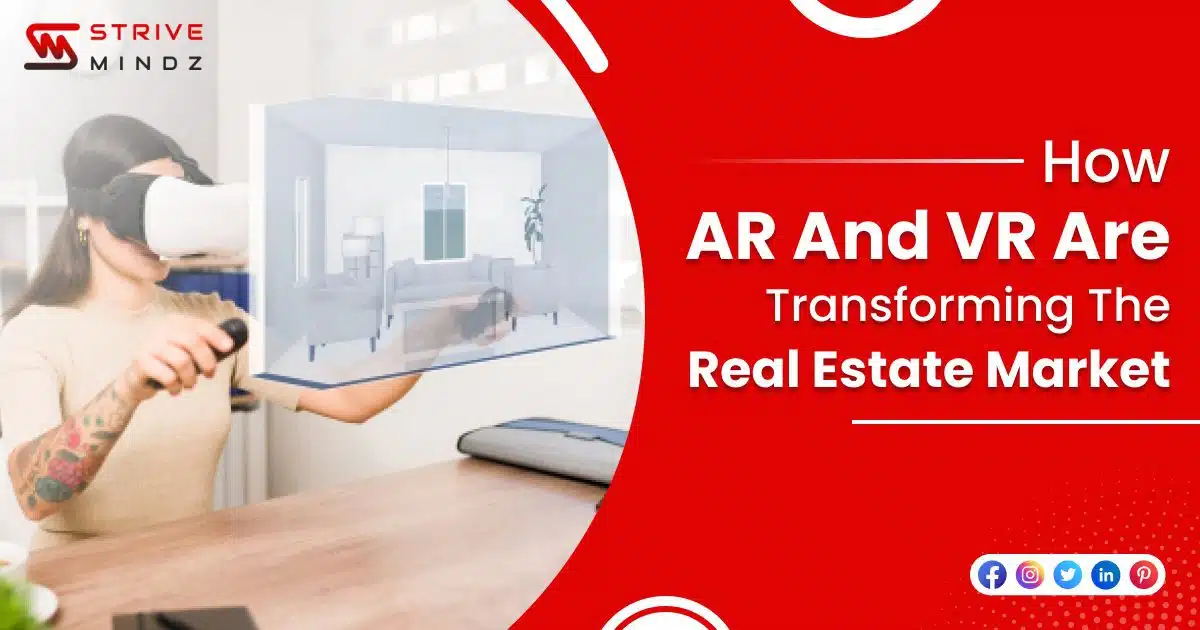How AR/VR Technology Are Transforming The Real Estate Market?

Introduction to AR/VR Technology in Real Estate: Imagine the ability to step into a property and explore every detail without physically being there! Thanks to Augmented Reality (AR) and Virtual Reality (VR), prospective buyers can now take virtual tours of homes, gaining a realistic understanding of the space, layout, and ambience.
It eliminates geographical limitations, enabling buyers to explore properties from anywhere in the world. With AR/VR technology, buyers and sellers can now even virtually decorate spaces using 3D models. The adoption of AR/VR in real estate holds immense potential, providing a new level of immersive interaction and visualization.
Beyond residential properties, AR/VR also benefits commercial real estate. With it, businesses can visualize office spaces, retail layouts and industrial facilities before making crucial leasing or purchasing decisions. AR/VR empowers investors and developers to assess the potential of a property and make well-informed choices.
In this article, we will explore how the integration of AR/VR technology in the real estate industry is transforming the way properties are bought and sold. It enhances the buyer’s journey by providing immersive experiences, personalized customization and a global reach. For sellers and agents, AR/VR opens up new possibilities for showcasing properties and attracting a wider audience. As AR/VR continues to advance, we can expect the real estate landscape to evolve, offering a more engaging and efficient experience for all involved.

Table of Contents
Understanding AR/VR Technology
AR and VR are often mentioned together, but they are not the same. AR is a technology that enhances the user’s view of the real world by overlaying digital information, whereas VR creates a completely immersive environment that simulates the real world or an imaginary one. Both technologies use headsets or mobile devices to provide a user-friendly experience.
What Is Virtual Real Estate?
Virtual real estate refers to the digital representation of properties that can be explored and experienced through VR technology. It allows potential buyers to virtually walk through properties, visualize spaces and get a realistic sense of the property’s layout, features and potential. Virtual real estate offers an immersive experience that goes beyond static images or videos, providing a more engaging and interactive way to explore properties.
What Is Augmented Reality in Real Estate?
Augmented reality provides buyers with additional information about a property as they explore it physically. By using a smartphone or tablet, buyers can view properties through an augmented reality app and see additional details such as property history, nearby amenities, or even potential renovations.
Benefits Of AR/VR In the Property Market
Virtual reality offers numerous benefits to both buyers and sellers in the property market. For buyers, it eliminates the need for physical property visits, saving time and effort. They can explore multiple properties from the comfort of their own homes, getting a realistic sense of the space without stepping foot inside. Virtual reality also allows buyers to visualize renovations or interior design changes, helping them make informed decisions.
Sellers, on the other hand, benefit from a wider reach and increased exposure. Virtual reality real estate tours enable sellers to showcase their properties to potential buyers worldwide, eliminating geographical barriers. This expanded reach can attract more potential buyers, leading to faster sales and increased profits. Virtual reality also allows sellers to present their properties in the best possible light, enhancing the marketing and sales process.
Augmented reality also benefits sellers by enabling them to showcase properties in a more interactive and engaging way. By providing additional information and visualizations, augmented reality can help buyers envision the potential of a property and make faster, more informed decisions. This technology creates a unique selling point for sellers, setting their properties apart from the competition and attracting more potential buyers.
The Growth of AR/VR in the Real Estate Industry
The use of AR/VR technology has grown exponentially in the real estate sector. According to a report by a leading global investment banking, securities and investment management firm, the VR/AR market in real estate is expected to reach $2.6 billion by 2025. The growth of this technology has been fueled by the need for a more innovative and effective way of selling, designing and viewing properties. The technology has also been embraced by developers and real estate agents who see it as a way of standing out from their competitors.
How AR/VR Technology is Enhancing the Property Tour Experience
-
Virtual Property Tours: A Game Changer
The traditional property tour can be a time-consuming and frustrating process for potential buyers. However, with the use of VR technology, property tours have been transformed into a more immersive and engaging experience. VR technology allows buyers to take a virtual tour of the property from anywhere in the world, providing a detailed and accurate representation of the property. This saves buyers time and makes the buying process more efficient.
-
Creating Interactive Property Tours with AR/VR
With AR technology, real estate agents can create interactive and personalized property tours. AR can be used to add virtual objects and information to the physical environment, making the tour more informative and engaging. For example, an agent can use AR to showcase the potential of an empty room by using virtual furniture and decor. This technology allows buyers to visualize themselves in the property and make informed decisions.
AR/VR Technology for Property Design and Development
Virtual Reality for Property Design
VR technology is also being used in property design and development. Architects and developers can use VR to create virtual models of buildings and landscapes, allowing them to test different design concepts and make informed decisions. VR technology makes it easier to identify design flaws and visualize the final product, saving time and resources in the development process.
AR for Property Development Planning
AR is also being used in property development planning. Using AR technology, developers can visualize and superimpose virtual objects on real-world spaces, giving them valuable insight into the property’s potential. For example, developers can use AR to project a 3D model of a proposed development onto an empty lot, allowing them to see how it would look in the real world. This technology makes it easier to plan, design and communicate development projects.
The Impact of AR/VR Technology on Property Marketing and Sales
Improving Property Marketing with AR/VR Technology
AR and VR technology are also transforming the way properties are marketed. Agents can use AR/VR to create visually engaging and interactive marketing materials. For example, agents can use VR to create a virtual neighbourhood tour and showcase the amenities of the area. This technology allows agents to stand out from their competitors and provide potential buyers with a more immersive and engaging experience.
AR/VR technology also has the potential to revolutionize the way properties are sold. With AR technology, agents can provide buyers with more personalized and accurate information about the property. For example, an agent can use AR to overlay important information about the property, such as square footage, property features, and price. This technology makes the buying process more transparent, efficient and informative.
AR/VR Technology for Property Management and Maintenance
As technology continues to advance, the real estate industry has a lot to gain from the integration of augmented reality (AR) and virtual reality (VR). One area that has a lot of potential for AR/VR is property management and maintenance.
AR/VR for Property Maintenance
AR/VR can be used to simplify the inspection and maintenance process of a property. Depending on the software used, it is possible to create a 3D model of the property that can be accessed remotely. This eliminates the need for physical inspections and reduces the chances of errors and delays.
For instance, if a tenant reports a malfunctioning faucet, a technician can use AR/VR to access the 3D model of the property and identify the faucet’s exact location. This saves time and ensures that the right repair is carried out.
Property Management with AR/VR
AR/VR can also enhance the property management process. Property managers can use AR/VR to give virtual tours of the property to prospective tenants, reducing the need for physical viewings. This can save time and make the viewing process more convenient for both the property manager and the tenant.
The technology can also be used to create a virtual staging of a property. This means that even if a property is empty, potential tenants can see how it would look furnished. This can increase the perceived value of the property and help it rent faster.
The Future of AR/VR Technology in Real Estate
-
Trends and Predictions for AR/VR in Real Estate
The use of AR/VR in the real estate industry is still in its early stages, but there are already some trends and predictions. One of the predictions is that AR/VR will become more mainstream for property management and maintenance. As the technology becomes more accessible, more real estate companies will embrace its use.
Another emerging trend in the industry is the advancement of increasingly advanced software solutions. The current software is already impressive, but there is still room for improvement. As the software improves, the possibilities for AR/VR in real estate will increase.
-
Challenges and Opportunities for AR/VR in Real Estate
Despite the many benefits of AR/VR for the real estate industry, there are still some challenges. The biggest challenge is the cost of implementing the technology. The software and hardware required for AR/VR can be expensive.
However, implementing AR/VR also presents an opportunity for real estate companies to differentiate themselves in a crowded market. By embracing technology, companies can enhance their service and provide a better experience for their tenants and clients.
Also Read: Shaping Tomorrow’s Realities: Exploring the Future Trends of AR and VR
Conclusion
AR/VR has the potential to revolutionize the property market by simplifying property management and maintenance and enhancing the tenant and client experience. While there are still challenges to overcome, the benefits of AR/VR in real estate are too significant to ignore.
As technology continues to develop, we can expect to see more real estate companies embracing AR/VR to improve their services and enhance the property market. In conclusion, AR/VR technology has tremendous potential to transform the real estate industry. From improving property tours, property management, design and development, marketing, and sales, this technology offers numerous benefits for industry stakeholders.
It’s clear that AR/VR is here to stay and will continue to evolve and shape the way we experience real estate. As the industry continues to embrace this technology, we can expect to see more innovative applications and use cases in the future.
Strivemindz offers AR and VR web and mobile app development services tailored specifically for the real estate industry. A team of experts creates immersive virtual experiences that allow users to explore properties uniquely. Whether it’s a 360-degree virtual tour or an augmented reality app, we deliver customized solutions to meet the specific needs of each client. Also provides comprehensive support to ensure optimal performance. By embracing these technologies, real estate businesses can differentiate themselves, engage potential buyers, and drive sales.
Step into a world where properties come to life, and imagination meets innovation. Welcome to the immersive realm of AR/VR technology in real estate.


